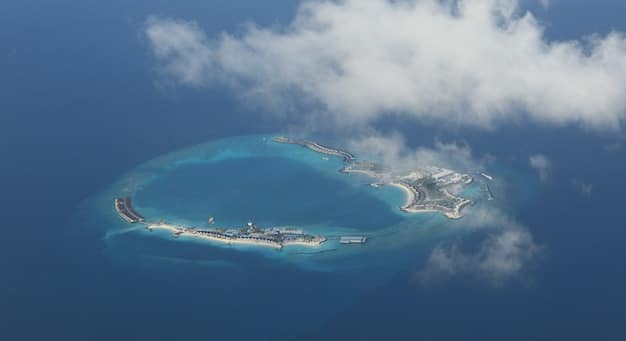US-China Relations: Trade, Security, and Diplomacy Complexities

The relationship between the United States and China is a multifaceted and challenging dynamic, characterized by intricate interdependencies in trade, contrasting approaches to security, and complex diplomatic engagements that frequently shift between cooperation and competition.
The intricate dance of global power often culminates in the complex relationship between two economic giants: the United States and China. Understanding US Relations with China: Navigating the Complexities of Trade, Security, and Diplomacy is paramount, as their interactions profoundly shape the geopolitical landscape, influence global markets, and set precedents for international cooperation and competition.
The Economic Intertwine: Trade and Technology
The economic relationship between the United States and China is arguably the most significant bilateral trade dynamic in the world. For decades, it has been characterized by deep interdependence, with China serving as a major manufacturing hub for US consumption and a growing market for American goods and services. However, this partnership has increasingly faced scrutiny and friction, particularly regarding trade imbalances, intellectual property theft, and market access issues.
For many years, US policy largely favored engagement, believing that economic liberalization would eventually lead to political reform in China. This approach fostered massive economic growth for both nations, but also led to the hollowing out of some American manufacturing sectors and a significant trade deficit. The sheer volume of goods exchanged, from electronics to textiles, created a supply chain deeply integrated across the Pacific.
Trade Imbalances and Tariffs
The persistent trade deficit with China has been a recurring point of contention for successive US administrations. Critics argue that China’s state-sponsored enterprises, subsidies, and non-tariff barriers create an unfair playing field. This led to a significant escalation in trade tensions, notably with the imposition of tariffs by the US starting in 2018.
- Targeted Tariffs: The US levied tariffs on billions of dollars worth of Chinese goods, citing unfair trade practices and intellectual property theft.
- Retaliatory Measures: China responded with its own tariffs on American agricultural products and other goods, impacting US farmers and businesses.
- Economic Impact: While initially intended to force concessions, these tariffs imposed costs on consumers and businesses in both countries, leading to supply chain adjustments.
These trade disputes highlighted the fragility of the economic ties, exposing vulnerabilities and forcing companies to rethink their global supply chains. The concept of “decoupling” or “de-risking” began to gain traction, albeit slowly, as both nations explored ways to reduce their reliance on each other in critical sectors.
Technological Competition and National Security
Beyond traditional trade, the competition in technology has emerged as a central pillar of the US-China relationship. Washington has grown increasingly concerned about Beijing’s ambitions to become a global leader in advanced technologies like artificial intelligence, 5G, semiconductors, and biotechnology. This competition is viewed primarily through a national security lens, with fears that China’s technological dominance could grant it a strategic advantage.
The US has implemented various measures to curb China’s access to vital technologies, including export controls, restrictions on Chinese tech companies like Huawei and TikTok, and efforts to boost domestic semiconductor manufacturing. These actions are often framed as necessary to protect national security interests and prevent the dual-use of technologies for military purposes.
Conversely, China views these restrictions as an attempt to stifle its economic development and maintain US technological hegemony. Beijing has responded by doubling down on its own innovation efforts, investing heavily in research and development, and promoting indigenous technological self-sufficiency. This accelerating technological race carries significant implications for global innovation, intellectual property rights, and future economic competitiveness.
The constant tug-of-war over trade and technology underscores a fundamental shift in the US-China economic relationship. No longer simply partners in globalization, they are now increasingly viewed as strategic competitors, even as their economies remain deeply intertwined. Navigating this new reality requires balancing economic benefits with national security imperatives, a task that proves increasingly challenging for both sides.
Security Challenges: Regional and Global Implications
The security dimension of US-China relations is multifaceted, encompassing regional flashpoints, military modernization, and differing strategic objectives across the globe. While both nations share some common interests, particularly in counter-terrorism and non-proliferation, their divergent views on international norms, territorial claims, and military postures create significant areas of tension.
Taiwan and the South China Sea
Among the most volatile flashpoints is Taiwan. The US maintains a “One China” policy but also a commitment under the Taiwan Relations Act to ensure Taiwan’s ability to defend itself, a policy known as “strategic ambiguity.” China views Taiwan as an integral part of its territory, to be reunified, by force if necessary. This fundamental disagreement poses a constant risk of escalation, especially with increased Chinese military activity near the island and growing US political and military support for Taiwan.
The South China Sea is another critical area of contention. China asserts historical claims over vast portions of the sea, building artificial islands and militarizing features, actions that are contested by several Southeast Asian nations and deemed illegal under international law by an arbitration tribunal. The US, while not a claimant, conducts freedom of navigation operations to challenge what it perceives as excessive Chinese maritime claims and uphold international law. This creates frequent encounters between naval forces and heightens the risk of miscalculation.
- Taiwan Strait: A critical geopolitical fault line, with China’s military modernization aiming to deter any move towards formal independence.
- Freedom of Navigation: US operations assert the right of passage in international waters, challenging China’s expansive claims.
- Regional Allies: The US seeks to strengthen its alliances with countries like Japan, South Korea, the Philippines, and Australia to counterbalance China’s growing military presence.
The US engagement in these regions is viewed by China as an attempt to contain its rise, while the US perceives China’s actions as a challenge to the rules-based international order and a threat to regional peace and stability. The potential for a direct military confrontation in either of these areas remains a significant concern for policymakers globally.
Military Modernization and Strategic Competition
Both the US and China are engaged in extensive military modernization programs, each viewing the other as a primary strategic competitor. China’s People’s Liberation Army (PLA) has undergone rapid transformation, investing heavily in naval capabilities, air power, cyber warfare, and advanced missile systems designed to counter US conventional military advantages. The development of anti-access/area-denial (A2/AD) capabilities is a particular focus, aimed at deterring foreign intervention in potential conflicts.

The US military, in turn, is adapting its strategies and capabilities to address China’s evolving military power. This includes modernizing its own forces, strengthening alliances, and developing new doctrines to operate in contested environments. The focus is on maintaining a credible deterrent and ensuring the ability to project power in the Indo-Pacific region.
This military competition extends beyond conventional forces to emerging domains such as space and cyber. Both nations are developing advanced capabilities in these areas, raising concerns about potential vulnerabilities and the implications for future conflicts. The lack of robust crisis communication mechanisms and confidence-building measures between the two militaries further exacerbates the risk of misperception or accidental escalation.
Addressing these security challenges requires a delicate balance of deterrence and dialogue. While strengthening defense capabilities is deemed necessary, maintaining open lines of communication and pursuing arms control discussions are vital to prevent miscalculations and manage the inherent risks of strategic competition. The long-term implications of this security dynamic will shape global peace and stability for decades to come.
Diplomatic Engagements: Bridging Ideological Divides
Diplomacy forms the third critical pillar of US-China relations, serving as the primary avenue for managing complex issues, de-escalating tensions, and identifying areas of potential cooperation. Despite profound ideological differences and recurring periods of friction, both nations recognize the necessity of maintaining channels for dialogue, given the global implications of their interactions.
Areas of Cooperation and Shared Interests
Despite the prevailing narrative of competition, there are areas where the US and China have historically found common ground and where cooperation remains essential. Climate change is a prominent example, with both countries being the world’s largest emitters of greenhouse gases. Their collaboration is widely seen as indispensable for global efforts to mitigate climate change, as evidenced by joint declarations and agreements made in the past.
Other potential areas for cooperation include global health crises, such as pandemics, where coordinated responses are crucial for effective containment and vaccine distribution. Non-proliferation efforts, particularly regarding nuclear weapons and weapons of mass destruction, also represent a shared interest, even if approaches to specific proliferators may differ. Furthermore, stability in certain regions, counter-terrorism, and addressing transnational crime often require some level of communication and intelligence sharing.
- Climate Change: Joint efforts are crucial for global mitigation strategies.
- Global Health: Coordinated responses to pandemics and disease outbreaks.
- Non-Proliferation: Shared interest in preventing the spread of WMDs.
- Macroeconomic Stability: Dialogue on global financial stability and growth.
These areas of mutual interest often provide a pragmatic basis for engagement, even when broader geopolitical relations are strained. They offer opportunities to build trust and demonstrate that cooperation is possible, even between strategic rivals. However, the extent and depth of this cooperation are often contingent on the overall state of the bilateral relationship and the political will of both leaderships.
Human Rights, Democracy, and Values
A significant ideological divide centers on human rights and political systems. The US consistently advocates for democratic values, freedom of speech, religious freedom, and human rights globally, often raising concerns about China’s treatment of ethnic minorities in Xinjiang, the suppression of democracy in Hong Kong, and broader civil liberties issues within mainland China. These concerns are deeply rooted in American foreign policy principles and often reflect strong bipartisan sentiment.
China, on the other hand, views these critiques as interference in its internal affairs, emphasizing sovereignty and non-interference as core tenets of its foreign policy. Beijing often frames its system as superior for achieving economic development and social stability, rejecting Western models of democracy. This ideological clash frequently fuels diplomatic arguments and contributes to public distrust on both sides, complicating efforts to build a more stable relationship.
The directness with which these issues are addressed publicly and privately can fluctuate depending on the political climate and the priorities of respective administrations. While some argue that human rights concerns should always be front and center, others advocate for a more nuanced approach that balances these concerns with other strategic objectives. The tension between values and pragmatism remains a constant feature of US-China diplomacy, making comprehensive agreements more difficult to achieve beyond very specific issues.
Ultimately, diplomatic engagement between the US and China is a continuous, complex process of managing differences while seeking minimal common ground. It involves high-level summits, ministerial dialogues, and lower-level exchanges, all aimed at preventing misunderstandings and keeping lines of communication open. The success of this diplomacy often lies not in resolving fundamental disagreements, but rather in preventing them from spiraling into unmanageable conflicts.
Geopolitical Ripples: Alliances and International Order
The US-China relationship extends far beyond their bilateral interactions, sending significant ripples across the global geopolitical landscape. The competition between these two powers shapes regional dynamics, influences international institutions, and impacts the very nature of the global order. Their respective approaches to alliances and multilateralism reflect contrasting visions for the future.
US Alliance System and Indo-Pacific Strategy
A cornerstone of US foreign policy, particularly in the Indo-Pacific, is its network of alliances. Treaties with Japan, South Korea, Australia, the Philippines, and Thailand form a robust security architecture designed to maintain regional stability and deter aggression. These alliances have gained renewed importance in the context of China’s growing military and economic influence, as the US seeks to reassure its partners and demonstrate its commitment to the region.
The Quadrilateral Security Dialogue (Quad) involving the US, Japan, Australia, and India, and the AUKUS security pact between Australia, the UK, and the US, are examples of initiatives aimed at strengthening cooperation among like-minded democracies to address shared challenges, prominently including China’s assertiveness. These groupings focus on areas such as maritime security, critical technologies, and supply chain resilience, often framing their efforts as promoting a free and open Indo-Pacific.
From the US perspective, these alliances are essential for collectively addressing issues ranging from maritime security in the South China Sea to economic coercion. They represent a multilateral approach to balancing power and upholding international norms. The goal is not necessarily to isolate China but to ensure that its rise is consistent with a rules-based order, rather than one dominated by raw power.
However, China views these alliances with suspicion, often labeling them as relics of the Cold War designed to contain its development. Beijing argues that such blocs are destabilizing and contribute to a confrontational mentality. The strategic implications of these alliances are profound, influencing military postures, trade relationships, and diplomatic alignments across Asia and beyond.
China’s Belt and Road Initiative and Global Ambitions
In contrast to the US-led alliance system, China’s primary outward-looking strategy is the Belt and Road Initiative (BRI). Launched in 2013, the BRI is a massive infrastructure development and investment project extending across Asia, Europe, Africa, and Latin America. It involves building roads, railways, ports, power plants, and telecommunications networks, aiming to connect China more closely with global markets and expand its geopolitical influence.

While China presents the BRI as a win-win for connectivity and economic development, critics, particularly in the US, express concerns about “debt trap diplomacy,” where countries indebt themselves to China for projects that may not be financially sustainable. There are also concerns about the strategic implications of China gaining access to critical infrastructure, dual-use facilities, and greater political leverage in partner countries.
- Infrastructure Development: Massive investments in ports, railways, and energy across continents.
- Economic Influence: Expanding China’s trade routes and market access.
- Geopolitical Leverage: Building political ties and influence through economic partnership.
- Debt Concerns: Debates over the sustainability of loans and potential “debt traps.”
The BRI represents a key component of China’s broader ambition to reshape the international order and create a more “multipolar” world, where its influence is commensurate with its economic and military might. It challenges established institutions and norms, particularly those historically shaped by Western powers, and offers an alternative model for global development and governance.
The differing approaches to global influence—the US relying on its alliance system and established international institutions, and China leveraging economic initiatives like the BRI—highlight a fundamental competition over the future of the international order. Managing this competition peacefully and constructively is a central challenge for both nations and the international community at large.
Future Trajectories: Competition, Cooperation, or Confrontation?
Projecting the future of US-China relations into the next decade is inherently complex, given the multitude of variables at play. The relationship will likely continue to be defined by a delicate balance between intense competition, selective cooperation, and the ever-present risk of confrontation. Understanding the key factors that will shape this trajectory is crucial for policymakers and global stability.
Managing Strategic Competition
The prevailing consensus is that strategic competition will remain the dominant theme. This competition encompasses economic leadership, technological supremacy, military power projection, and ideological influence. Both nations perceive the other as a primary long-term competitor, leading to a constant vying for advantage in various domains. This dynamic is not cyclical but represents a more fundamental reordering of global power.
Managing this competition will require sophisticated statecraft. For the US, this means strengthening its own economic and technological foundations, reinvigorating its alliances, and enhancing its military deterrent capabilities. For China, it involves pursuing its “dual circulation” economic strategy, deepening its ties with Global South nations, and continuing its military modernization. The challenge will be to ensure that competition does not spill over into unchecked rivalry or, worse, direct conflict.
This management likely involves establishing “guardrails” or mechanisms to prevent miscalculation and escalation. This could include regular top-level diplomatic exchanges, military-to-military communication channels, and possibly agreements on norms for behavior in emerging domains like cyber and space. The aim is not to eliminate competition, which is inherent, but to keep it within a framework of managed rivalry.
Opportunities for Selective Cooperation
Despite intense competition, opportunities for selective cooperation will persist, driven by shared global challenges. Climate change remains a prime example where cooperation is not merely desirable but arguably essential. Beyond climate, global pandemics, financial stability, and certain aspects of counter-terrorism could necessitate joint action. These areas provide pragmatic avenues for engagement, even when broader relations are strained.
The extent of this cooperation will depend heavily on the political will of leaders and the ability of diplomats to carve out specific areas of collaboration that do not compromise core national security or economic interests. Such cooperation is unlikely to be broad or transformative, but rather transactional and issue-specific. It will serve as a constant reminder that despite their differences, the two powers are inextricably linked by global challenges that transcend national borders.
- Climate Action: Continued, although perhaps challenging, cooperation on emissions and renewable energy.
- Pandemic Response: Necessity of coordination during future global health crises.
- Financial Stability: Dialogue on managing global economic downturns and market volatility.
- Regional Crises: Potential for joint or coordinated diplomatic efforts on specific issues.
These cooperative efforts, however modest, are important for demonstrating that the relationship is not solely defined by antagonism. They also offer a lifeline for dialogue and can help build minimal levels of trust, which can be crucial during times of heightened tension. The challenge lies in preventing the competitive aspects of the relationship from overwhelming these crucial areas of shared interest.
Risk of Confrontation and Accidental Escalation
The most concerning trajectory is the risk of confrontation, whether by design or accidental escalation. Flashpoints like Taiwan and the South China Sea, coupled with an arms race in advanced military technologies, create a volatile environment. Miscalculation, misperception, or an unintended incident could rapidly escalate without robust crisis management mechanisms.
The increasing frequency of close encounters between US and Chinese military assets, particularly in the air and sea, heightens this risk. The absence of comprehensive arms control treaties between the two military powers, coupled with a lack of transparency regarding military intentions and capabilities, contributes to a climate of mistrust. Continuous dialogue channels at all levels, particularly military-to-military, are absolutely critical to mitigate these risks and ensure that incidents do not spiral out of control.
Ultimately, the future of US-China relations will be a continuous negotiation of power, interests, and values. It will not be a return to the engagement of the past, nor is it likely to be a full-scale Cold War. Instead, it seems poised to be a period of intense and complex strategic competition, punctuated by selective cooperation on shared global problems, all while navigating significant risks of confrontation. The ability of leaders on both sides to manage this inherently challenging relationship will be a defining feature of 21st-century geopolitics.
| Key Point | Brief Description |
|---|---|
| 📊 Trade & Tech Friction | Economic interdependence faces challenges from trade imbalances, tariffs, and intense technological competition. |
| ⚔️ Security Flashpoints | Taiwan and the South China Sea remain significant areas of military and geopolitical tension. |
| 🤝 Selective Diplomacy | Despite ideological divides, cooperation exists on issues like climate change and global health. |
| 🌍 Global Influence Tug-of-War | US alliances and China’s BRI reflect contrasting visions for the global order. |
Frequently Asked Questions About US-China Relations
▼
The primary economic issues include the persistent US trade deficit with China, allegations of intellectual property theft, forced technology transfers, and concerns over China’s state-subsidized industries. These issues have led to tariff disputes and discussions about “de-risking” global supply chains to reduce reliance on each other.
▼
Taiwan is a central flashpoint due to China’s claim of sovereignty over the island and the US’s “One China” policy which acknowledges this, while simultaneously committing to Taiwan’s self-defense. Increased Chinese military activity and growing US support for Taiwan raise constant concerns about potential conflict and regional stability.
▼
Both the US and China are engaged in significant military modernization, viewing each other as strategic competitors. This competition spans conventional forces, cyber warfare, space, and advanced missile systems. The goal for both is to maintain deterrence and project power, which often leads to heightened tensions and a need for clear communication.
▼
Despite broad competition, the US and China find common ground on several global issues. Climate change is a key area where their cooperation is deemed essential due to their significant emissions. Other areas include global health crises, such as pandemics, and certain non-proliferation efforts aimed at preventing the spread of weapons of mass destruction.
▼
The US largely relies on its established alliance system and multilateral institutions to project influence and maintain a rules-based order. China, in contrast, often uses its Belt and Road Initiative (BRI) and economic partnerships to expand its global reach, offering an alternative model for development and governance, leading to a competition for influence.
Conclusion
The relationship between the United States and China fundamentally shapes the 21st-century geopolitical landscape. Far from a simple dichotomy of cooperation or conflict, it is a dynamic and intricate tapestry woven from highly interdependent economic threads, deeply contested security interests, and a complex web of diplomatic engagements. As distinct global powers with differing political systems and national ambitions, both nations navigate a path marked by strategic competition, yet tempered by the undeniable need for selective cooperation on critical global challenges. The ability to manage this inherent complexity, mitigate risks, and foster areas of mutual benefit will be paramount not only for their own bilateral stability but for the broader international order.





